
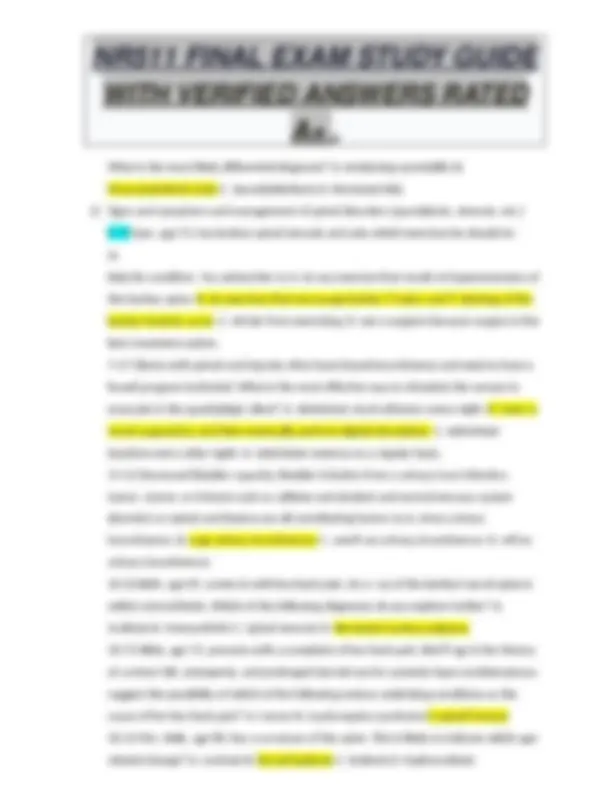
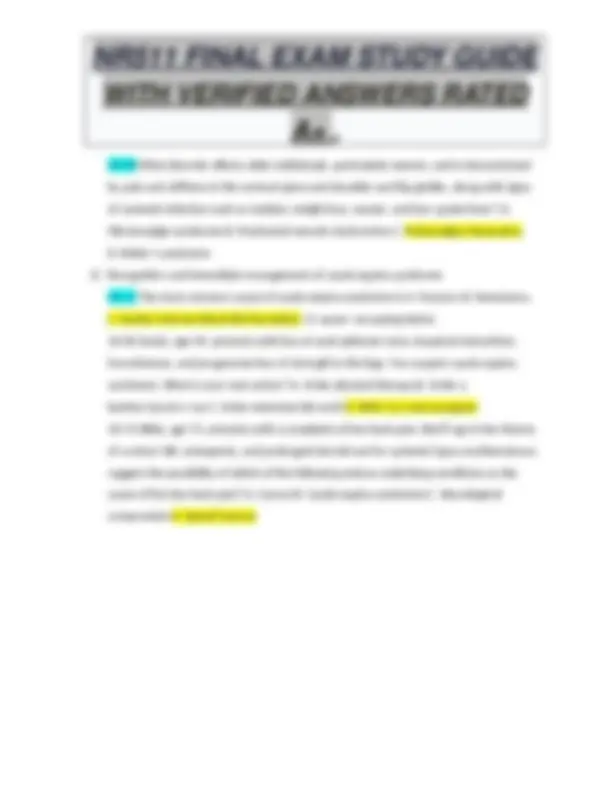
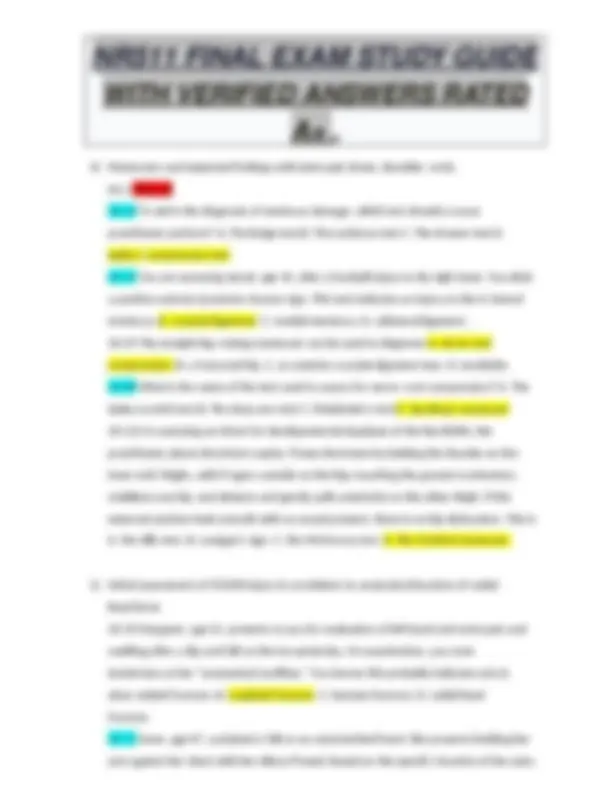
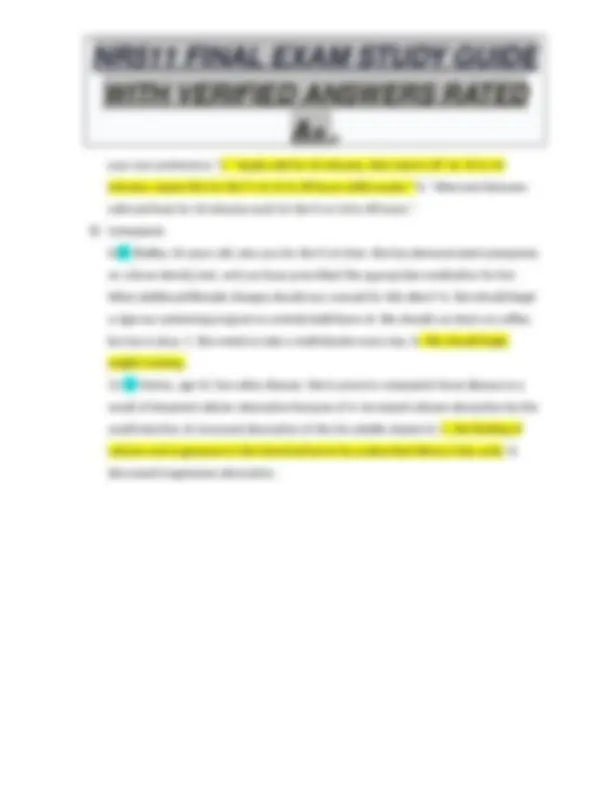
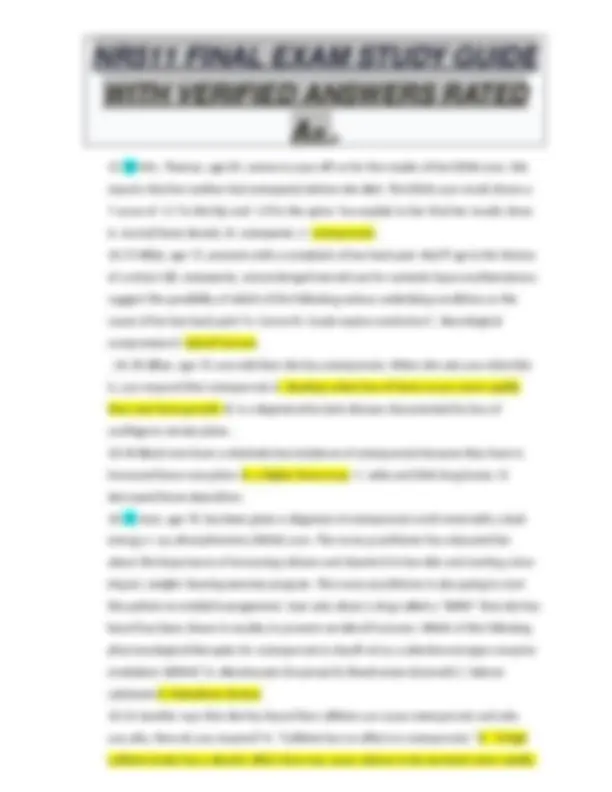
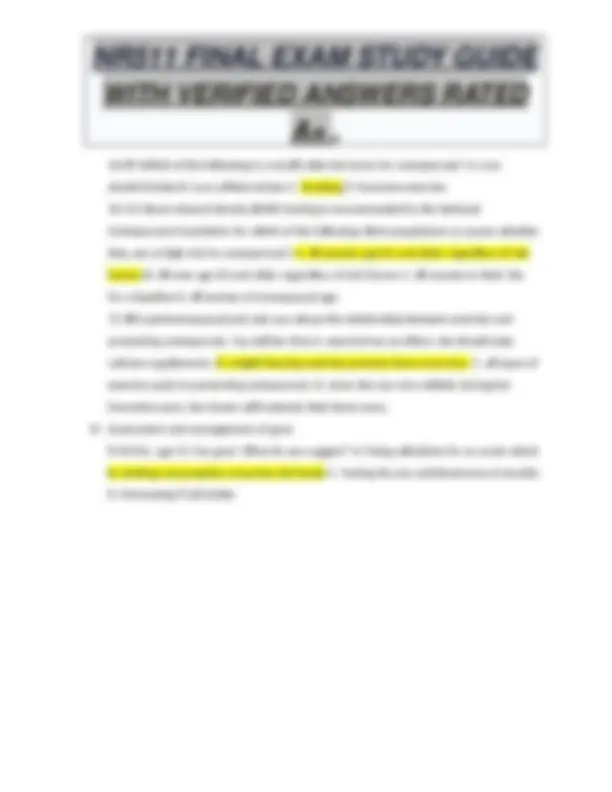
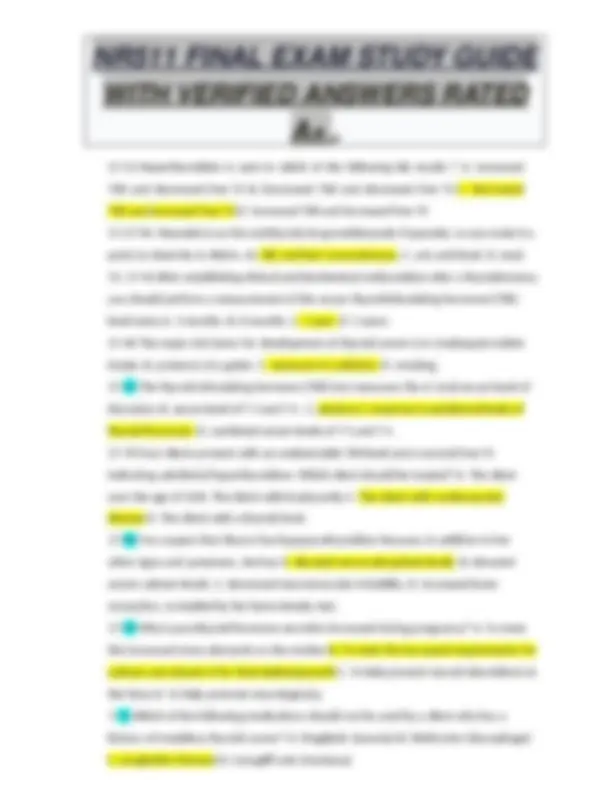
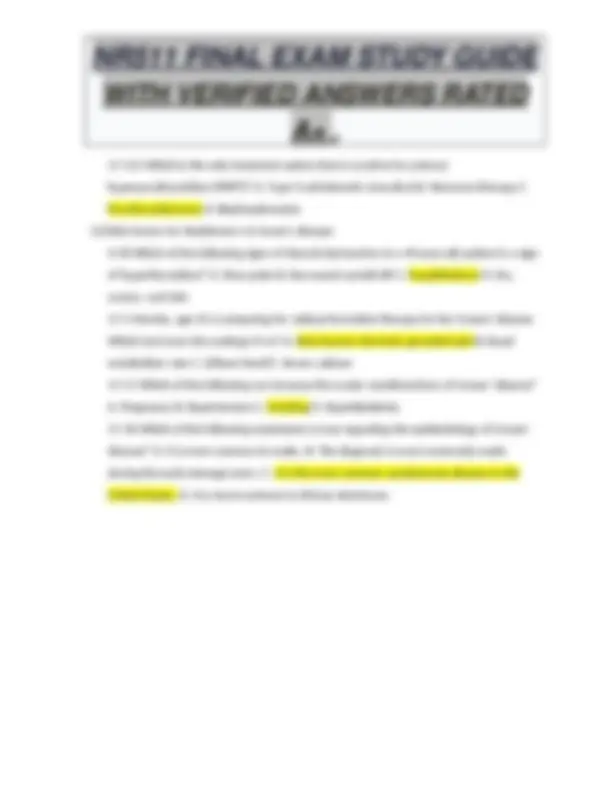
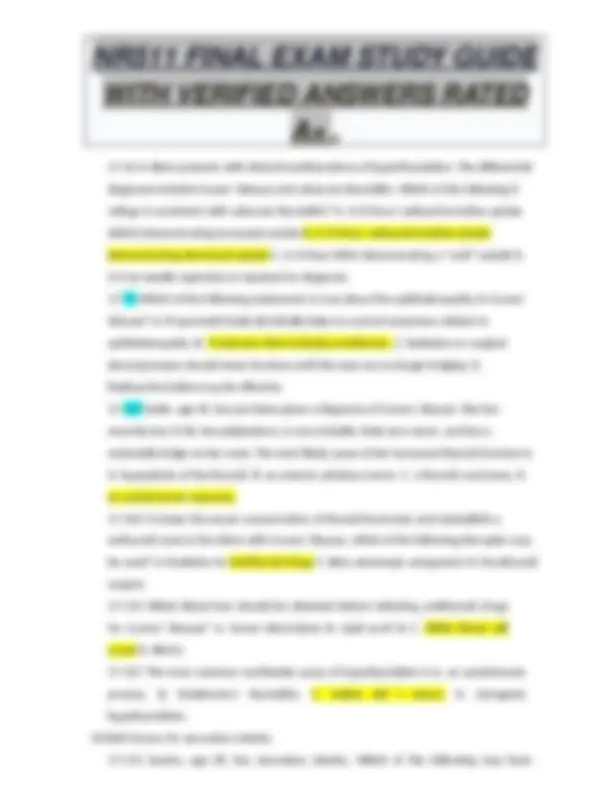
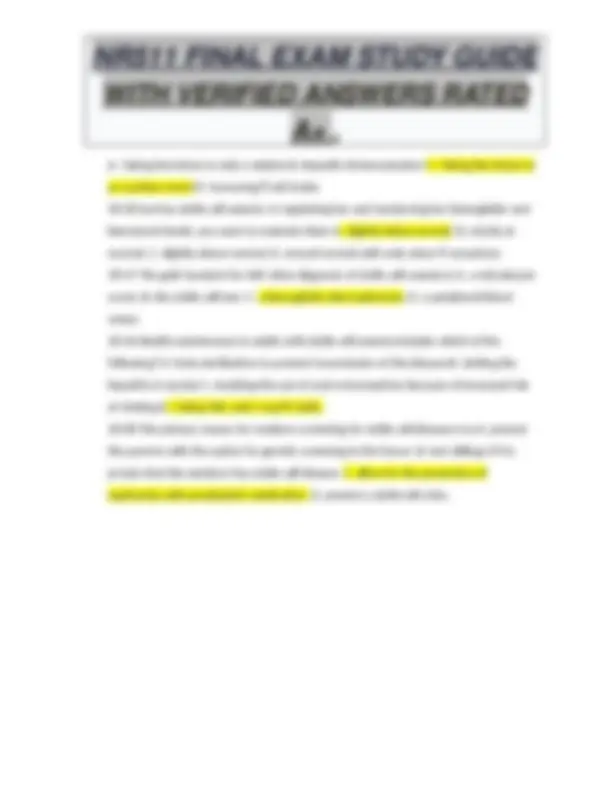
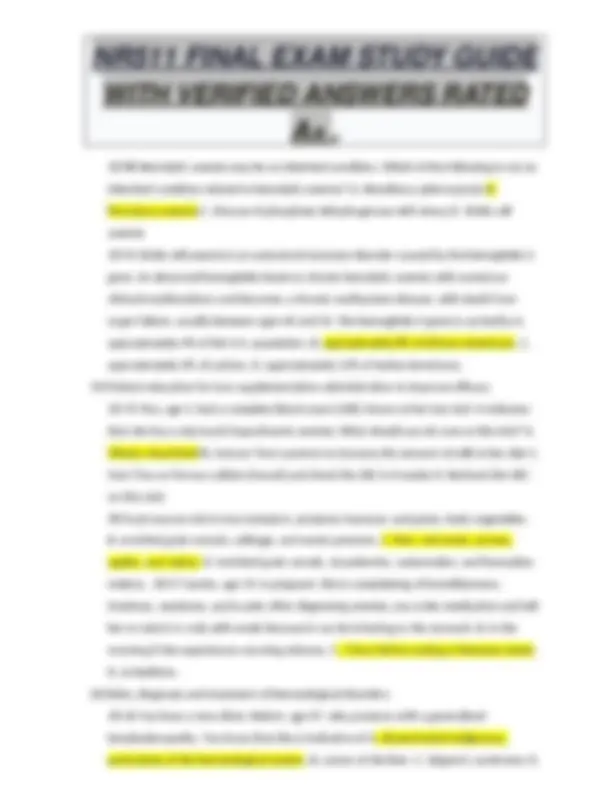
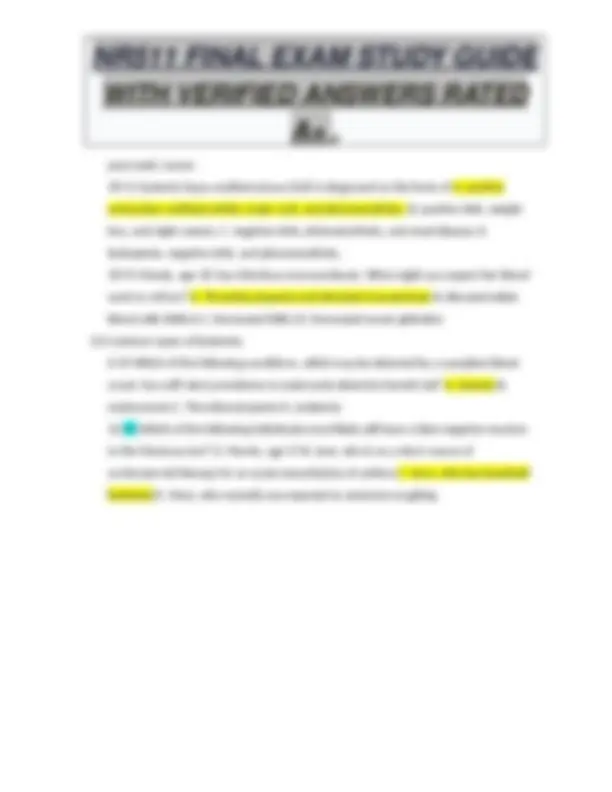
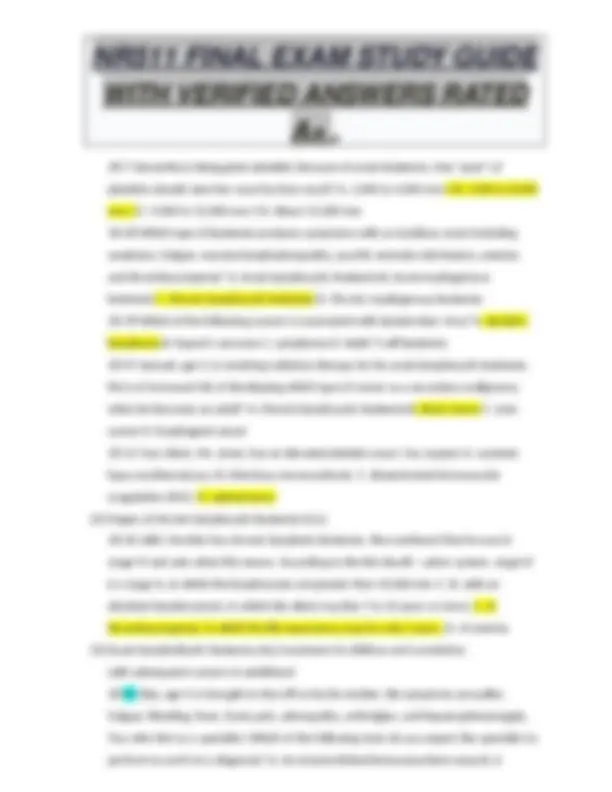
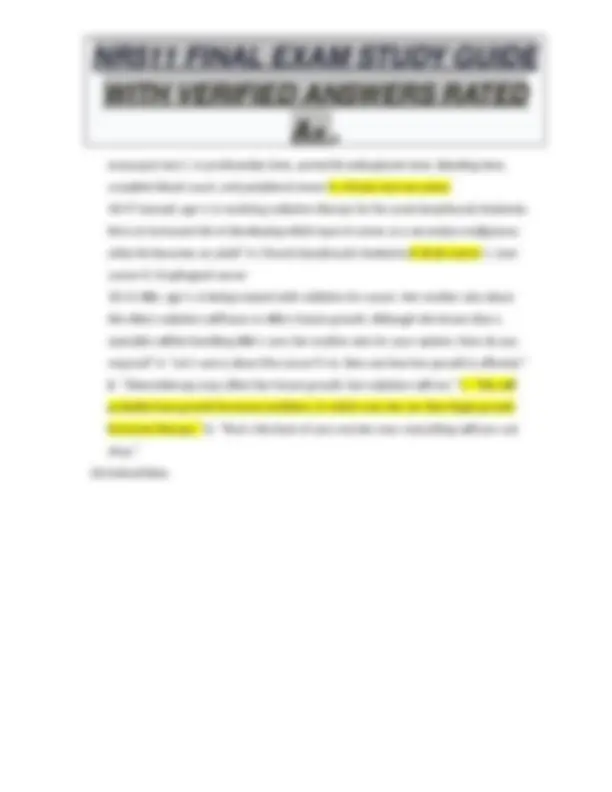
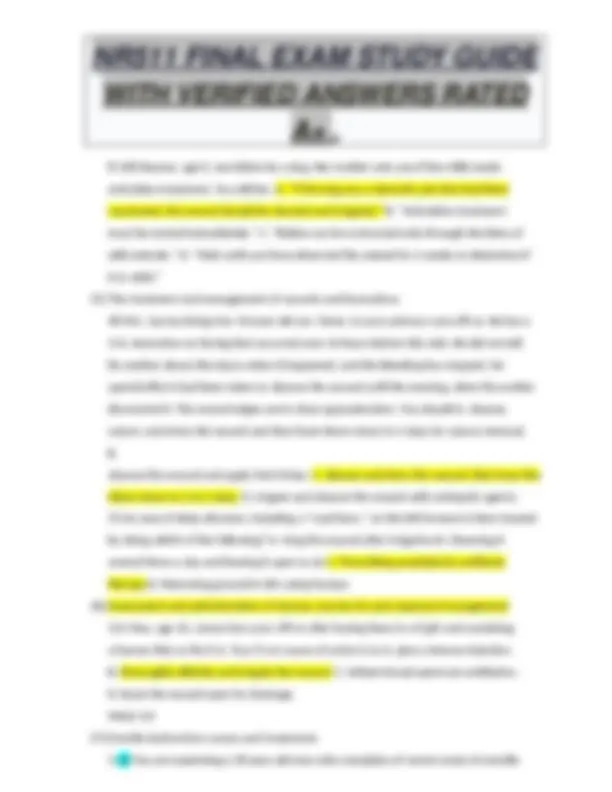
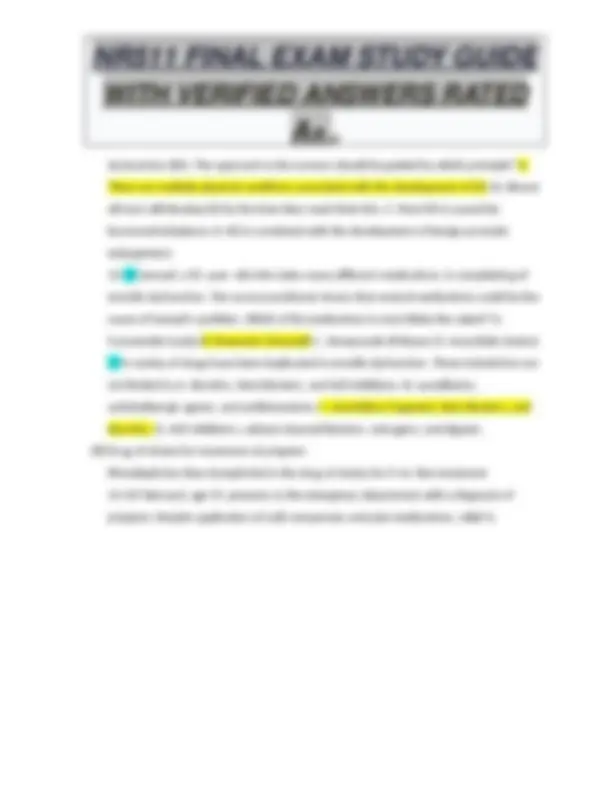
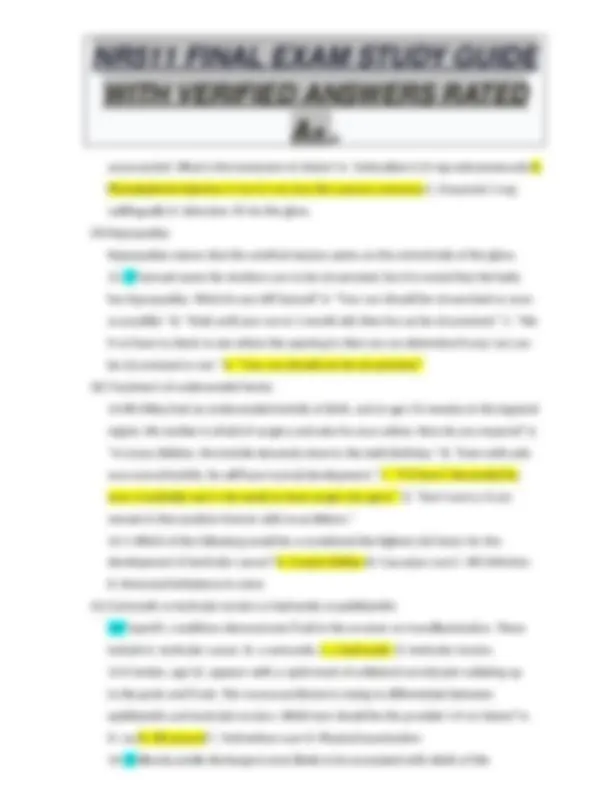
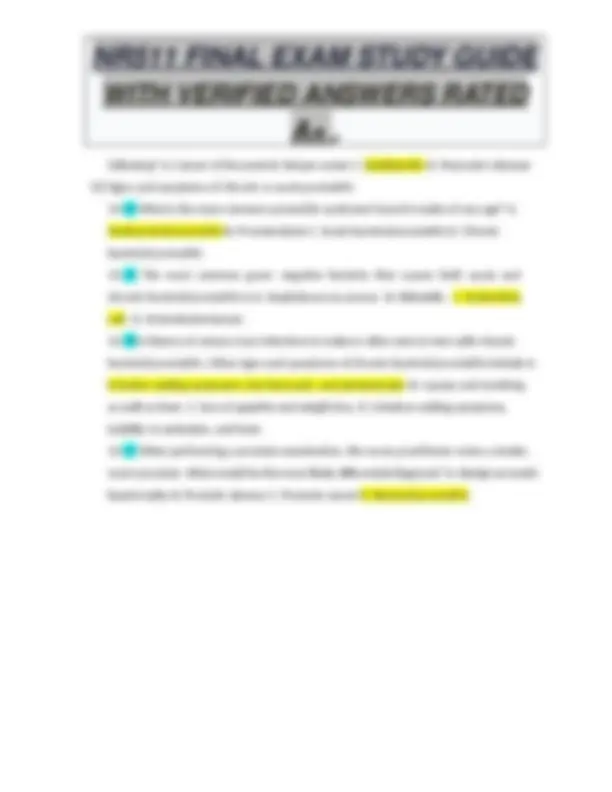
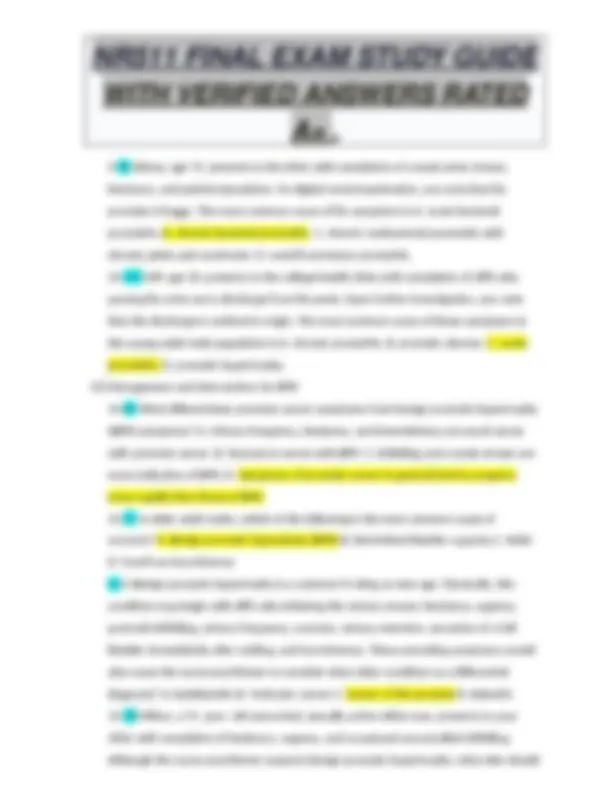
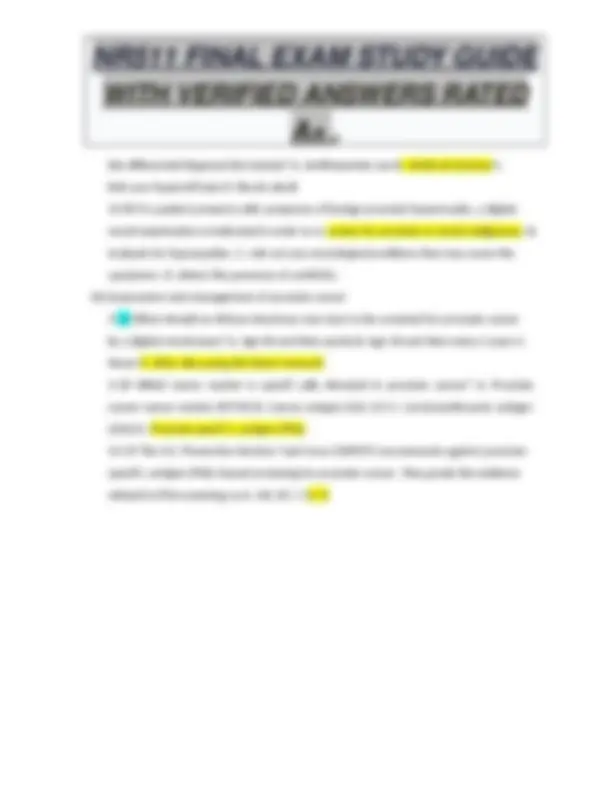
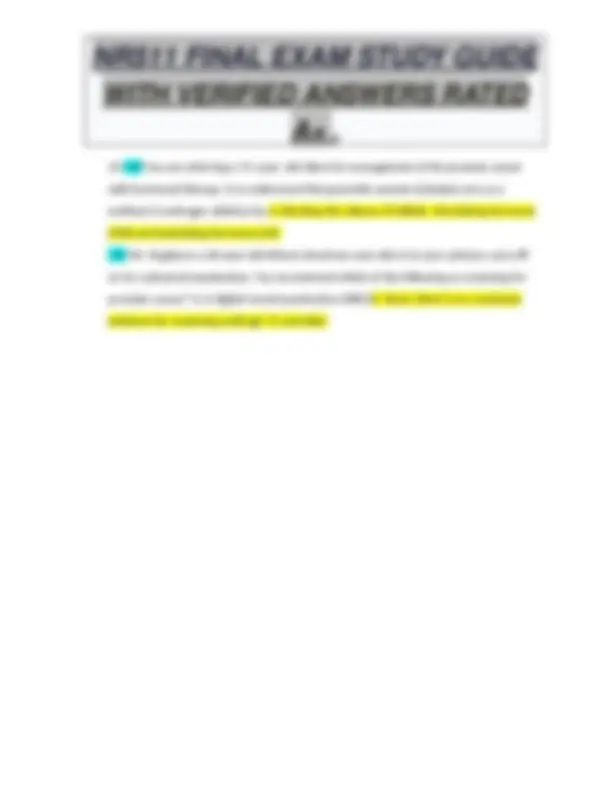


Study with the several resources on Docsity

Earn points by helping other students or get them with a premium plan


Prepare for your exams
Study with the several resources on Docsity

Earn points to download
Earn points by helping other students or get them with a premium plan
Community
Ask the community for help and clear up your study doubts
Discover the best universities in your country according to Docsity users
Free resources
Download our free guides on studying techniques, anxiety management strategies, and thesis advice from Docsity tutors
A study guide for the final exam of nr511, providing verified answers and explanations for various health conditions, including joint pain, thyroid disorders, anemia, and leukemia. It covers maneuvers and expected findings, medications, and diagnostic tests.
Typology: Exams
1 / 29

This page cannot be seen from the preview
Don't miss anything!






















A. the Allis test. B. Lasègue’s sign. C. the McMurray test. D. the Ortolani maneuver. 16-124 Emily, age 12, presents to the clinic with another muscle strain from one of her many sports activities. The nurse practitioner thinks that the patient was probably never taught about health promotion and maintenance regarding physical activity. What information should be included in patient teaching? A. “After an activity, if any part hurts, apply ice for 20 minutes.” B. “You must fi rst get in shape with a rigorous schedule of weight training, and then you can participate in any activity once you are physically fi t.” C. “After any strenuous activity, you must completely rest your muscles before beginning your next activity.” D. “Stretching and warm- up exercises are an important part of any exercise routine.” 16-27 Upon assessment, the nurse practitioner notes unilateral back pain that had an acute onset and increases when standing and bending. A straight- leg test is negative. The most likely differential diagnosis is A. herniated nucleus pulposus. B. muscle strain. C. osteoarthritis. D. spondylolisthesis. 16-67 June, age 67, presents with back pain with no precipitating event. The pain is located over her lower back and muscles without sciatica, and it is aggravated by sitting, standing, and certain movements. It is alleviated with rest. Palpation localizes the pain, and muscle spasms are felt. There was an insidious onset with progressive improvement.
16-90 What disorder affects older individuals, particularly women, and is characterized by pain and stiffness in the cervical spine and shoulder and hip girdles, along with signs of systemic infection such as malaise, weight loss, sweats, and low- grade fever? A. Fibromyalgia syndrome B. Myofascial somatic dysfunction C. Polymyalgia rheumatica D. Reiter’s syndrome
16-16 Which of the following is NOT a management principal for an acute musculoskeletal injury that does not require emergent treatment? A. RICE B. NSAIDs or acetaminophen C. Imaging studies D. Skeletal muscle relaxants. 16-86 James, age 17, has been complaining of a painful knob below his right knee that has prevented him from actively participating in sports. He has recently been given a diagnosis of Osgood-Schlatter disease and asks you about his treatment options. The nurse practitioner should tell him that the initial treatment is A. relative rest; he could benef i t from hamstring, heel cord, and quadricep stretching exercises. B. immobilization; a long- leg knee immobilizer is recommended. C. surgical intervention; removal of the bony fragments is necessary. D. bedrest for 1 week.. 16-124 Emily, age 12, presents to the clinic with another muscle strain from one of her many sports activities. The nurse practitioner thinks that the patient was probably never taught about health promotion and maintenance regarding physical activity. What information should be included in patient teaching? A. “After an activity, if any part hurts, apply ice for 20 minutes.” B. “You must fi rst get in shape with a rigorous schedule of weight training, and then you can participate in any activity once you are physically fi t.” C. “After any strenuous activity, you must completely rest your muscles before beginning your next activity.” D. “Stretching and warm- up exercises are an important part of any exercise routine.”. 16-15 When Maxwell, age 12, slid into home plate while playing baseball, he injured his ankle. The nurse practitioner is trying to differentiate between a sprain and a strain. A sprain A. is an injury to the ligaments that attach to bones in a joint. B. is an injury to the tendons that attach to the muscles in a joint. C. is an injury resulting in extensive tears of the muscles. D. is an injury that does not result in joint instability.. 16-98 Alexander, age 12, sprained his ankle playing ice hockey. He is confused as to whether to apply heat or cold. What should the nurse practitioner tell him? A. “Use continuous heat for the fi rst 12 hours and then use heat or cold to your own preference.” B. “Use continuous cold for the fi rst 12 hours and then use heat or cold to
your own preference.” C. “Apply cold for 20 minutes, then take it off for 30 to 45 minutes; repeat this for the f i rst 24 to 48 hours while awake.” D. “Alternate between cold and heat for 20 minutes each for the fi rst 24 to 48 hours.”
16-89 Which of the following is a modifi able risk factor for osteoporosis? A. Low alcohol intake B. Low caffeine intake C. Smoking D. Excessive exercise 16-121 Bone mineral density (BMD) testing is recommended by the National Osteoporosis Foundation for which of the following client populations to assess whether they are at high risk for osteoporosis? A. All women age 65 and older regardless of risk factors B. All men age 65 and older regardless of risk factors C. All women in their 30s for a baseline D. All women of menopausal age. 72 Jill is perimenopausal and asks you about the relationship between exercise and preventing osteoporosis. You tell her that A. exercise has no effect; she should take calcium supplements. B. weight-bearing exercise prevents bone mass loss. C. all types of exercise assist in preventing osteoporosis. D. since she was very athletic during her formative years, her bones will maintain their bone mass.
8-92 Gouty pain in the great toe is A. toe gout. B. hyperuricemia of the toe. Podagra 16-82 The nurse practitioner is considering a diagnosis of calcium pyrophosphate dihydrate (CPPD) crystal deposition disease or pseudogout in a 72- year- old man who presents with complaints of pain and stiffness in his wrists and knees. The most useful diagnostic test to assist in confi rming this diagnosis would be CPPD disease (pseudo gout) may appear clinically similar to gouty arthritis; 16-118 Gout is caused by urate crystals being deposited in certain joints leading to acute pain, erythema and edema. Gout typically occurs most often in the joint of the A. foot. B. wrist. C. elbow. D. fi nger. 17- 24 Which of the following medications can increase uric acid and lead to an acute gouty attack? A. HCTZ B. Beta blockers C. Calcium channel blocker D. ACE inhibitors Medication management for acute vs. chronic gout A uricosuric such as Probenecid, with the addition of the antiinf l ammatory colchicine, is indicated for chronic gouty arthritis. 17-4 What is the medication of choice for an initial acute attack of gout? A. An NSAID 16 -2 Colchicine may be used to terminate an acute attack of gouty arthritis as well as to prevent recurrent episodes. The mechanism of action is to A. interrupt the cycle of urate crystal deposition and inf l ammatory response. B. increase serum uric acid levels. C. potentiate the excretion of uric acid. D. inhibit the tubular reabsorption of urate, promoting the excretion of uric acid. 16-7 Bursitis is an infl ammatory process that may be caused by infection, trauma, repetitive movement disorders, gout, or neoplastic disease. The most common cause of septic bursitis due to infection is from which of the following? Staph aureus
17-13 Hyperthyroidism is seen in which of the following lab results? A. Increased TSH and decreased free T4 B. Decreased TSH and decreased free T4 C. Decreased TSH and increased free T4 D. Increased TSH and increased free T 17-27 Mr. Reynolds is on the antithyroid drug methimazole (Tapazole), so you make it a point to check his A. HbA1c. B. CBC and liver transaminases. C. uric acid level. D. total T4. 17-44 After establishing clinical and biochemical euthyroidism after a thyroidectomy, you should perform a measurement of the serum thyroidstimulating hormone (TSH) level every A. 3 months. B. 6 months. C. 1 year. D. 2 years. 17-46 The major risk factor for development of thyroid cancer is A. inadequate iodine intake. B. presence of a goiter. C. exposure to radiation. D. smoking. 17- 69 The thyroid-stimulating hormone (TSH) test measures the A. total serum level of thyroxine. B. serum level of T 3 and T 4. C. pituitary’s response to peripheral levels of thyroid hormone. D. combined serum levels of T 3 and T 4. 17-76 Four clients present with an undetectable TSH level and a normal free T indicating subclinical hyperthyroidism. Which client should be treated? A. The client over the age of 50 B. The client with bradycardia C. The client with cardiovascular disease D. The client with a thyroid bruit 17- 80 You suspect that Sharon has hypoparathyroidism because, in addition to her other signs and symptoms, she has A. elevated serum phosphate levels. B. elevated serum calcium levels. C. decreased neuromuscular irritability. D. increased bone resorption, as implied by her bone density test. 17- 89 Why is parathyroid hormone secretion increased during pregnancy? A. To meet the increased stress demands on the mother B. To meet the increased requirements for calcium and vitamin D for fetal skeletal growth C. To help prevent neural tube defects in the fetus D. To help promote neurological g 7- 92 Which of the following medications should not be used by a client who has a history of medullary thyroid cancer? A. Sitagliptin (Januvia) B. Metformin (Glucophage) C. Liraglutide (Victoza) D. Canaglifl ozin (Invokana)
17-115 Which is the only treatment option that is curative for primary hyperparathyroidism (PHPT)? A. Type II calcimimetic cinacalcet B. Hormone therapy C. Parathyroidectomy D. Bisphosphonates
caused this? A. An intake of more calories than are expended B. Polycystic ovary disease C. Her antihypertensive medications D. Her sedentary lifestyle
18-94 Your client, Shirley, has an elevated mean cell volume (MCV). What should you be considering in terms of diagnosis? A. Iron-defi ciency anemia B. Hemolytic anemias C. Lead poisoning D. Liver disease
18-88 Hemolytic anemia may be an inherited condition. Which of the following is not an inherited condition related to hemolytic anemia? A. Hereditary spherocytosis B. Pernicious anemia C. Glucose-6-phosphate dehydrogenase defi ciency D. Sickle cell anemia 18-95 Sickle cell anemia is an autosomal recessive disorder caused by the hemoglobin S gene. An abnormal hemoglobin leads to chronic hemolytic anemia with numerous clinical manifestations and becomes a chronic multisystem disease, with death from organ failure, usually between ages 40 and 50. The hemoglobin S gene is carried by A. approximately 4% of the U.S. population. B. approximately 8% of African Americans. C. approximately 4% of Latinos. D. approximately 12% of Native Americans.
pancreatic cancer. 18-51 Systemic lupus erythematosus (SLE) is diagnosed on the basis of A. positive antinuclear antibody (ANA), malar rash, and photosensitivity. B. positive ANA, weight loss, and night sweats. C. negative ANA, photosensitivity, and renal disease. D. leukopenia, negative ANA, and photosensitivity. 18-91 Mandy, age 18, has infectious mononucleosis. What might you expect her blood work to refl ect? A. Thrombocytopenia and elevated transaminase B. Elevated white blood cells (WBCs) C. Decreased WBCs D. Decreased serum globulins